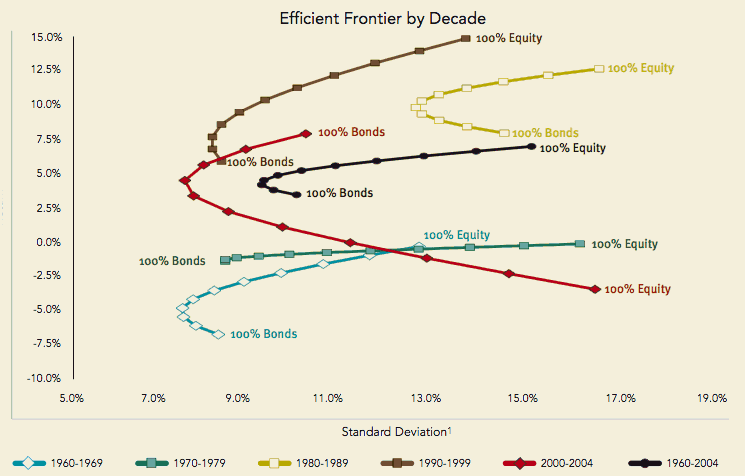Thanks to Cb for posting the efficient frontier curves. I had never seen before one (just one) curve lowering risk and increasing return. BTW, this 2000-2004 episode is so special that it corresponds to the example I gave, describing conditions I would be ready to hold bonds, stock market diving, low inflation, rates decreasing. It is very particular as most often, the stock market dives because of inflation and / or recession (and therefore bonds dive as well). So be it, there is always a highly specific counter-example to the general rule.
More generally and over one century (1901-2001), de Laulanié in "Les Placements de l'Epargne à Long Terme" studies various efficient frontier portfolios trying to maximize returns and to lower risks. I would just mention two portfolios one with RE (RE in Paris) and the other without. The first (P1) is 25% french stocks, 25% US stocks and 50% RE and delivers at the efficient frontier elbow 4,5% real return (above inflation) with a 3% sigma. The second (P2) is 40% french stocks, 35% US stocks, 15% french bonds, 10% cash (Treasuries) and delivers 4,2% real returns with a 2,1% sigma
But, one has to notice that in terms of years of losses, P1 is much better than P2. P1 would have had only three years of losses (1930, 1974, 1994) and only one with a loss slightly > 10% (1930), whereas the second would have had 8 years of losses over a century with two years of losses greater than 20% in 1930 and 1974. Therefore P2 is highly more volatile than P2 and delivers a bit less !
Delivering an informed opinion to the portfolio exposed by bbuzzard, would require to be able to study its response over decades and to locate the right blend on an efficient frontier of variants. Quite difficult, but interesting.
I return to bbuzzard portfolio (and anticipated moves) then I'll be back to Nords and Brewer comments (on steady streams of cash flow).
With respect to bonds now, high yields and emerging markets bonds seem to be less interesting today than US treasuries. Convertibles enable to participate to the (stock) market performance with a certain protection on the downside (as they have kind of an integrated optional structure which is cheap at the time due to low volat of the stock market at the moment). But again I would not increase bond exposure right now.
With respect to stocks, large caps are cheaper than small caps and I truely wonder whether I should not sell some EU small / mid caps which have simply sky rocketed. UK large caps are cheap (FTSE100 has a P/E 12,5 + a 3% div on FTSE100 ETFs). Emerging markets offer opportunities in China, Brazil, Thailand, Poland, Korea. In terms of sectors, finance and health-care are interesting (I keep loading HC). Finally listed RE keeps going through the roof in europe and france in particular !
In terms of ensuring a regular cashflow brewer must be (theoritically) right. But as a mere human being (trying to sleep at night

) I am so much more confident with a stream coming from commercial rental RE (as Nords pointed to in my case). But in terms of "regular cashflow portfolios" there must also exist an efficient frontier portfolio made of a mix of what Nords quoted (CDs, TIPS, bonds, RE, etc.), knowing that taxes (and how they apply to each investor) have a large impact on the end-result there. Changing residency to optimize taxes is a way of maximizing returns as well. I exclude pension as I have none

and hardly consider it as an asset class.
Well, I've enjoyed reading all your views.


